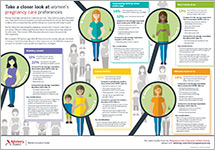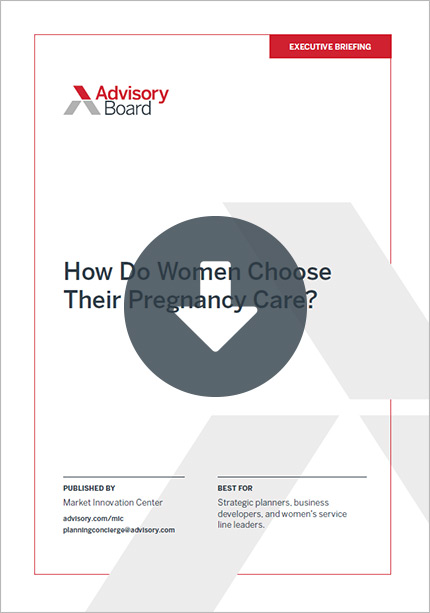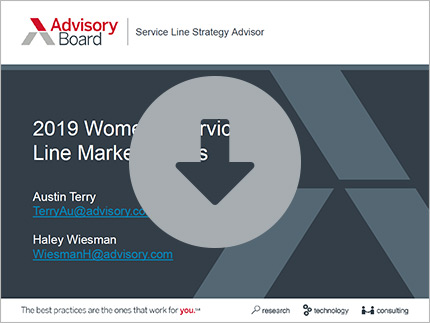Auto logout in seconds.
Continue LogoutIn the United States, egg donations offer young women a chance to make lucrative sums of money—but some experts say clinics tend to downplay the risks and complexity of the procedure, Paris Martineau writes for Wired.
Get ready-to-use slides on women's health market trends for 2019
The booming egg donation industry
The first U.S. child conceived from a donated egg was born in 1984. Since then, the egg donor industry has boomed in the United States, Martineau writes.
In many countries, egg donation is strictly regulated, and in others—including China, Germany, Italy, and Norway—egg donation is barred entirely. But, the United States has a "dearth of regulations" regarding egg donation for reproductive purposes, Martineau writes, making the United States a "magnet for overseas couples" looking to conceive.
Due to the high demand, egg donation can be very lucrative for U.S. donors. First-time donors will usually make about $8,000, with second-time donors making about $10,000. Donors with desirable traits, such as a "high IQ, Ivy League education, modelesque features, sought-after ethnic backgrounds, or unique skills," will often make over $20,000, Martineau writes. And some donor agencies will pay up to $50,000 per cycle, according to Martineau.
The strenuous egg donation process
To attract these "perfect" donors, some clinics and agencies turn to advertisements that offer potential donors a minimum of thousands of dollars to help aspiring parents "complete their family." Most of the advertisements imply that women can find out if they are fit to be a donor by taking a "short quiz."
But "[i]n practice," Martineau writes the process is "often more complicated," and some women have said they found the process to be misrepresented in marketing.
Before donors begin the egg extraction process, many agencies require potential donors to complete a medical genetic questionnaire and undergo genetic testing, a psychological screening, a medical screening, ultrasound, vaginal culture, and STD screening.
Once the women are approved as donors and are selected by an aspiring parent, the donors take medication to synchronize their menstrual cycle with the recipient's, and they have to inject themselves with drugs in the stomach or thigh numerous times per day for 10 days to accelerate egg production. The women, who are encouraged to abstain from any physical activity that might irritate their ovaries, also have to visit a doctor every one to three days for ultrasounds and bloodwork.
Once the injections are complete, the clinic schedules the extraction, during which a doctor uses "thick needles" to puncture the donor's vaginal walls and drain the follicles.
The process is not without risk of complications, Martineau writes. "Some women suffer a reaction to the fertility injections known as ovarian hyperstimulation syndrome, which in extreme cases can be fatal," she writes.
The potential risks of egg donation
But most potential donors are unaware of the complexity of the process or of the risks it poses, according to Martineau.
Ashleigh Griffin, a six-time egg donor, first found out about egg donations through an agency's Facebook ad in 2011. The ad said donors could earn thousands of dollars by donating eggs to help another family. When Griffin turned 21, she donated her eggs for the first time. Eventually, she donated six times at three different clinics and made $61,000. But in four out of the six procedures, Griffin said, her ovaries swelled and she experienced weight gain, severe nausea, abdominal pain, and trouble urinating. One time, Griffin was hospitalized so that doctors could drain fluid from her abdomen.
After the hospitalization, Griffin couldn't stand for three weeks and had to recover for two months. While Griffin said the clinic discussed potential side effects, she did not expect to be in so much discomfort. "I had no idea what was going on," she said.
Diane Tober, an assistant professor at the UC San Francisco, said that donating eggs is riskier than many agencies let on. According to Tober, some clinics downplay the long-term risks and may fail to mention the potential side effects, which include abdominal pain, nausea, vomiting, diarrhea, and weight gain. Other, more serious side effects can include ovarian torsion or those that require surgery.
Tober added that part of the problem is a lack of research into the effects of egg donation. "There's a huge lack of data there to really [allow women] to make informed decisions," Tober said. "And that's really problematic, obviously, when you have people making decisions that could affect their future health, well-being, and their ability to have children."
To understand the risks, some women turn to support groups
The lack of information can make the egg donation process "confusing and frightening," leaving potential donors "feeling isolated and unaware of the risks," Martineau writes.
"That first time when I got really sick, the worst part of that was feeling like doctors didn't understand what I was going through," Griffin said. "The [ED] staff didn't know, my friends didn't get it."
In response, some patients, including Griffin, have joined private Facebook groups where women can give advice about egg donation and seek out information about the process from others who have previously donated.
The private, invite-only groups allow women to "share the nitty-gritty details," such as "how best to deal with the pain of your ovaries swelling to the size of grapefruits, how to negotiate with doctors for safer hormonal doses … and even how to report the payments on tax returns," Martineau writes.
Some conversations give light to the "unusual" aspects of the egg donation process. According to Martineau, there are more than 12 posts about the challenges of bringing syringes full of hormones on planes.
For Griffin, the Facebook group was the only place where she could discuss the day-to-day process leading up to an egg donation. "It's a huge deal for me to have other people, even virtually, who have any idea [what it's like]," she said (Martineau, Wired, 4/23).
Get ready-to-use slides on women's health market trends for 2019
Want the latest information for your next women's health services meeting? We updated our most popular slides on women's health updated with the latest market trends in 2019.
This ready-to-use presentation covers everything from growth outlook and financial considerations to new care management priorities and technology innovations.
Don't miss out on the latest Advisory Board insights
Create your free account to access 1 resource, including the latest research and webinars.
Want access without creating an account?
You have 1 free members-only resource remaining this month.
1 free members-only resources remaining
1 free members-only resources remaining
You've reached your limit of free insights
Become a member to access all of Advisory Board's resources, events, and experts
Never miss out on the latest innovative health care content tailored to you.
Benefits include:
You've reached your limit of free insights
Become a member to access all of Advisory Board's resources, events, and experts
Never miss out on the latest innovative health care content tailored to you.
Benefits include:
This content is available through your Curated Research partnership with Advisory Board. Click on ‘view this resource’ to read the full piece
Email ask@advisory.com to learn more
Click on ‘Become a Member’ to learn about the benefits of a Full-Access partnership with Advisory Board
Never miss out on the latest innovative health care content tailored to you.
Benefits Include:
This is for members only. Learn more.
Click on ‘Become a Member’ to learn about the benefits of a Full-Access partnership with Advisory Board
Never miss out on the latest innovative health care content tailored to you.



